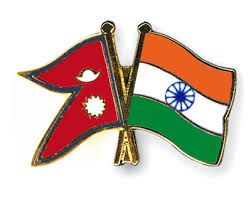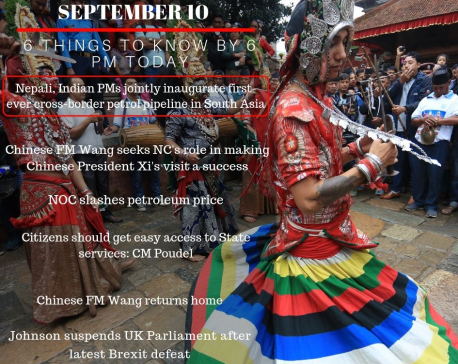
OR
#OPINION
Forging a Stronger Nepal - India Relationship: Overcoming Past Miscalculations
Published On: June 28, 2023 08:30 AM NPT By: Nabraj Lama


Nabraj Lama
The author is a research scholar with a primary focus on Himalayan Studies, international relations, political economy, and Indigenism. He is affiliated with the Himalayan Strategic Institute.news@myrepublica.com
More from Author
- Strengthening Indigenous Rights: Key to Peace and Prosperity in Nepal's Federal Era
- Unavoidable Realism of Nepal’s Geopolitical Strategy
- Nepal's 1923 Treaty with British India: A Centennial Reflection on Diplomatic Resilience and Sovereignty
- India's Role in South Asia: Pathways to Regional Prosperity and Peace
- The Unequal Balance of Power: Kathmandu's Dual Standard on Rule Enforcement
India and Nepal share a long history of friendship, cooperation, and cultural exchange. However, events like the 2015 blockade have significantly strained the relationship between the two nations. India's miscalculations in its approach towards Nepal have played a crucial role in causing these tensions. This article will explore the key issues that have driven a wedge between the countries, including intervention in Nepal's constitution-making process followed up by India's blockade in 2015, and undermining the indigenous nationalities as a potential power constituency in Nepal, while providing facts and figures to better understand the situation.
India has always played a vital role in Nepal's political transformations, such as abolishing the Rana rule in 1951, restoring democracy and ending the Panchayat system in 1990, and playing an influential role in ending the decade-long Maoist insurgency in 2006. India also facilitated a twelve-point understanding between the Maoist party and the then Seven Parties Alliance. Considering these major roles of India towards Nepal, being a neighboring country, the power-hub of South Asia, and an emerging global power, India's interest in involving itself in Nepal's constitution-making process was evident. However, the timing and process were undermining the Nepalese people, and as a result, the ruling elites of Nepal converted India's actions, which were aimed at benefiting the marginalized and excluded communities in Nepal, into an intervention in a sovereign nation. India's last-minute intervention to influence the constitution in favor of the Madheshi community and other marginalized communities was successfully diverted by the ruling elites of Nepal to the violation of Nepal's sovereignty. Similarly, the ruling elites sparked nationalism among the Nepali people, making them feel threatened by India's perceived control.
Furthermore, India supported the blockade led by the Madheshi community and particularly Madheshi-based political forces. The blockade of Nepal in 2015 lasted for over five months. India's goal was to create pressure on the political elites for not being able to manage the weaker voices within Nepal, among other reasons, but the ruling elites smartly and successfully diverted the main cause of the blockade to blaming India for the devastating consequences for the country. The mainstream news media and political forces focused on presenting only one side of the story, which emphasized the blockade's severe shortages of essential goods, fuel, and medicine, leading to a humanitarian crisis. This narrative successfully played on the emotions of Nepalese nationalism. No one dared to discuss how the new constitution was a step back from the interim constitution; instead, they focused on the narrative established by the ruling elites. This period saw GDP growth in Nepal plummet from 6.3% in 2014 to a mere 0.6% in 2015, as reported by the World Bank, and the reason for the fall in GDP was again blamed on the blockade by Nepalese mainstream, although it was also the impact of the earthquake. The mainstream narrative in Nepal successfully portrayed India as infringing on Nepal's sovereignty, which aggravated the tension between the nations. The problem was not only with the mainstream but also the Madheshi leadership's lack of preparedness for the consequences of their actions, which led to a strong backlash against India.
India's disregard for the surge in nationalism caused by its intervention further strained the relationship, as many Nepalis felt their concerns were not being taken seriously. Furthermore, India's perceived micro-management of the process was seen as intrusive, with many Nepalis feeling that India was trying to impose its will on their nation, although there was another side to the story that was overlooked by the country's mainstream. India's approach to the constitution-making process has been widely criticized by experts, who believe that it would have been more effective to engage in a dialogue from an early stage rather than intervening at the last hour in an attempt to influence the process directly. This event marked a significant turning point in the relationship between the two countries, highlighting the need for more cautious diplomacy.
Another point of contention is India's failure to recognize and cooperate with the potential political constituency led by indigenous people in Nepal's hilly regions. As a result, although the indigenous people and marginalized communities, including the Madheshi factor, make up a considerable portion of the population, they hold very little political power. Consequently, they were unable to not only lead the issue but also to understand and intervene in the smart move of the mainstreams against them. The ruling elites in Nepal have long dominated the government, with little focus on empowering the indigenous communities in hilly areas. This lack of representation has led to a sense of marginalization and exclusion among these communities, further fueling resentment towards India, which is perceived as supporting the established political powers. By not recognizing the potential power constituency of the indigenous people, India has missed an opportunity to strengthen its relationship with Nepal and to support a more inclusive political landscape in the country.
To strive for a stronger relationship with Nepal, India must adopt a more nuanced and considerate approach. This primarily involves mainstream political elites who have successfully and deeply portrayed India as the expansionist power of South Asia in the mindset of individuals, especially among the hilly people. And it is not easy to erase, no matter how hard India tries. Thus, it is time to play smartly. The nationalism issue is very strong and against India, and the major political elites can use this weapon at any time in the future, as they have used it in the past. Thus, India should be very attentive to it. Another most important point is that India now should also engage with the undeveloped political constituency of indigenous people in the hilly regions and facilitate coordination with the Madhesh-based powers. In addition, India should understand that today's Nepal is not like that of the 1970s. Indian media is another factor that fuels the disruption of Nepal-India relations. Thus, Indian media should understand and deal professionally with sensitive matters between Nepalese people regarding India’s involvement.
In conclusion, India's miscalculations in its approach towards Nepal have significantly strained the relationship between the two nations. By addressing the key issues that have driven the tensions and adopting a more considerate approach, India and Nepal can work together to forge a brighter future for both the nations. With populations of 1.2 billion and 30 million, respectively, India and Nepal have not only immense potential but, being neighbors, it is compulsory for collaboration and mutual growth. It is essential for both countries to recognize the importance of their relationship and strive to overcome the challenges that have strained it in recent years.
You May Like This

Hailey Baldwin reveals her secret to relationship with Justin Bieber
Life of celebrities is no different from others when it comes to marriage and Hailey Baldwin is proving the same. Read More...

Sept 10: 6 things to know by 6 PM today
Your daily dose of missed important news of the day. ... Read More...

Relationship, a Boon or a Bane?
With an unprecedented escalation in the rates of divorce and broken relationships, it feels imperative that we give serious attention... Read More...






Just In
- Challenges Confronting the New Coalition
- NRB introduces cautiously flexible measures to address ongoing slowdown in various economic sectors
- Forced Covid-19 cremations: is it too late for redemption?
- NRB to provide collateral-free loans to foreign employment seekers
- NEB to publish Grade 12 results next week
- Body handover begins; Relatives remain dissatisfied with insurance, compensation amount
- NC defers its plan to join Koshi govt
- NRB to review microfinance loan interest rate











Leave A Comment